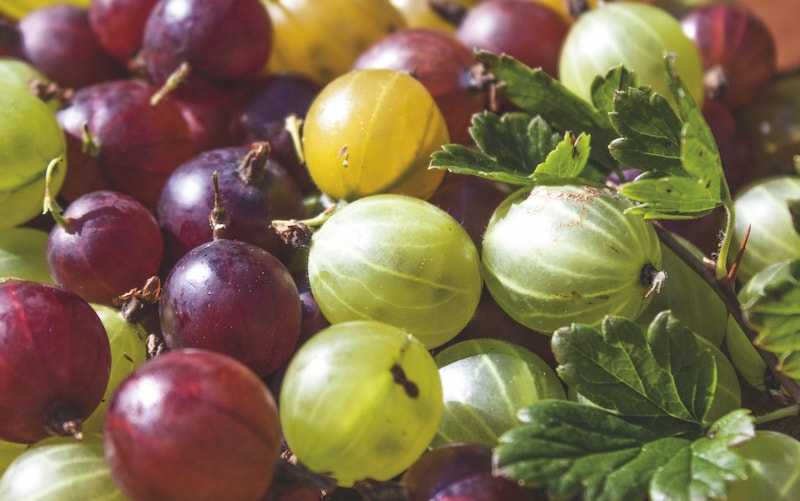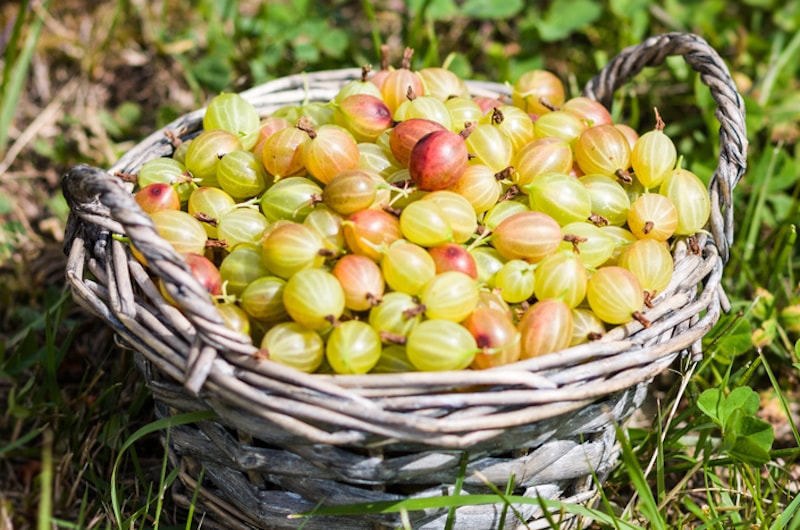If you’d like to know more about growing your own gooseberries, this is the place to start. Whether you’re a beginner gardener or a seasoned pro, our pick of the best independent advice on gooseberry growing is sure to help you get bumper crops year after year.
Gooseberries have a reputation for being tart little green fruits best suited to cooking and jam-making – but they’re so much more versatile than that. As well as culinary varieties normally found in the supermarket, gooseberries can also be sweet and juicy enough to eat straight off the bush. There are even thornless varieties! Order your gooseberry plants here and enjoy growing these superb little fruits in your own garden.
Contents:
- Advice on planting gooseberry bushes in the ground
- Advice on planting gooseberry bushes in containers
- Advice on pruning gooseberry bushes
- Advice on harvesting gooseberries
- What to do with your gooseberries
Advice on planting gooseberry bushes in the ground

Image: Gooseberry ‘Captivator’ from Suttons
The gorgeous gooseberry is the best fruit bush for beginners, according to Ben Vanheems of GrowVeg. This is because they “grow well in most soils, they’re very easy to prune, are self-pollinating”, and produce heavy crops of fruit. His easy-to-follow gooseberry growing guide is packed with advice including tips for more experienced gardeners looking to up their gooseberry game.
Want to plant a gooseberry bush in your garden? “If you’re starting your gooseberries between November and March, go for bare root plants,” advises the expert gardening team here at Suttons. If it’s already spring or summer, start with a potted gooseberry plant. Whichever you choose, this expert article provides a great overview of how to grow gooseberries along with a handy guide to the best varieties.
Over on YouTube, Woody of Cumbrian Homestead recommends growing gooseberries as single-stem cordons, especially where space is limited. Watch his video to see how he prepares cuttings to plant out as new cordons. By leaving three buds on each cutting, he hopes that at least one will be suitable for training into diagonal growth.
From space-saving cordons to decorative fans, there are several ways to grow gooseberry plants, says Marie of Plews Garden Design in her comprehensive article. How about a half standard gooseberry tree? With a tall, straight stem, this style has practical as well as aesthetic value, as it puts the fruit “at a more accessible height for those who find bending down a problem”. Read Marie’s full article for excellent, practical advice.
Advice on planting gooseberry bushes in containers

Image: Gooseberry ‘Hinnonmaki Yellow’ from Suttons
Dan of Home Gardens plants his young gooseberry bushes in pots, which is a great option if you’re short of space. In his how-to video, he recommends using a 30L container with handles to make it easier to move your gooseberry around. Watch the full video guide to find out which magic ingredients he adds to his special planting mix.
If you have a very young gooseberry bush that’s in need of a helping hand over winter, try potting it on. That’s what Ivan of Ivan’s Gardening Allotment UK did and it gave his little plant such a boost that it started fruiting! His top tip? Choose a heavy container that won’t get blown over in strong winds. Watch Ivan’s video guide to potting on a gooseberry bush and pick up more top tips.
Advice on pruning gooseberry bushes

Image: Gooseberry ‘Hinnonmaki Red’ Organic from Suttons
Nervous about pruning? Don’t be put off by the thorns, says Lee Burkhill of Garden Ninja – a good pair of gardening gloves will protect your hands. Gooseberries fruit on wood that is two to three years old, but removing some of the oldest stems each year encourages a constant supply of new branches to rejuvenate the bush. Lee recommends pruning gooseberries in early March when the buds are just breaking. “This is because it makes it easier to see which way the new growth is facing,” he explains. Watch his excellent video for an easy demonstration.
Pruning also helps combat pests and diseases, as Tony of Simplify Gardening explains in his excellent gooseberry pruning video. He prefers to prune in January, removing crossing branches and weak growth to open up the middle of the bush and improve airflow. “Ideally what we’re looking for is an upturned goblet shape,” he says, which discourages sawfly from laying eggs in the centre of the plant.
Advice on harvesting gooseberries

Image: Shutterstock
If rain is forecast, Ann Marie from @that.vegetablist likes to harvest her ripest gooseberries quickly “in case they swell too fast and split”. Having picked a kilo of ‘thinnings’ just a month earlier from the same bush, this second 1.3kg haul makes for an impressive crop. “Goosegogs aren’t for everyone, but you can’t deny they are super generous!” says Ann Marie. Take a peek at her hefty haul and pick up more practical tips over on her Insta.
If birds are regular visitors to your garden or allotment, net your gooseberries or risk losing your harvest, as Natasha of @dig_sow_grow found out this summer. She proudly shows off her “lil gooseberry harvest” on Instagram and looks forward to a bumper harvest next year when her nets are firmly in place!
Fruit harvesting is one of the best parts of having an allotment, according to Chris from @veggieplot. In summer he gets “fresh fruit every day at a fraction of the cost of the supermarkets, no silly plastic trays or packaging and no harmful sprays or chemicals!” Follow him on Instagram to see his absolutely gorgeous ‘Hinnonmaki Red’ gooseberries and find out what other fruits he grows alongside them.
Adam of Allotment Grow How grows a dessert variety of gooseberry at his allotment. These red fruits are much sweeter than the green ones, which he personally found a bit sour. Watch his fun video to see him picking his ripe gooseberries while demonstrating that he’s on first-name terms with a lot of his produce!
How do you know when your gooseberries are ripe? There are two ways to tell, says Claire of Claire’s Allotment. Firstly, give them a little squeeze: “there should be give in it… when they first come out they’re very hard, but as the weeks go on they get nice and squidgy.” And the second way to tell if your gooseberries are ready? Watch Claire’s video to find out!
What to do with your gooseberries

Image: Shutterstock
Rachel from @thegoodlifeainteasy would love to make something with her gooseberries but admits that she can’t stop herself from eating them “like sweets”. Her bowl of freshly-picked gooseberries would have been full to the brim had she and her young son not eaten so many! Rachel’s enthusiasm for gardening is infectious and her Instagram account is a joy.
No-dig allotmenteers @four_green_thumbs harvested nearly 6kg of gooseberries in June, picking them just a little early so the pigeons didn’t get them. A mere month later, they spent an evening “washing, sterilising and bottling 5.5 gallons of gooseberry wine”, amounting to 32 bottles’ worth! Suffice to say, we’re a little envious!
Now you know just how versatile gooseberries can be, we hope you’ll try growing your own. Whichever varieties you decide to try, our bloggers’ advice will help you make the most of these low-maintenance plants, enabling you to harvest delicious homegrown fruits for years to come.
Lead image: Organic Gooseberry ‘Invicta’ from Suttons
Last Updated on September 30, 2024 by Suttons Horticultural Team






Hi
Please can you tell me if you have any “Giant ” varieties as I’ve just joined the gooseberry society and I would like to enter a large heavy gooseberry
Kind regards
Steve Coles